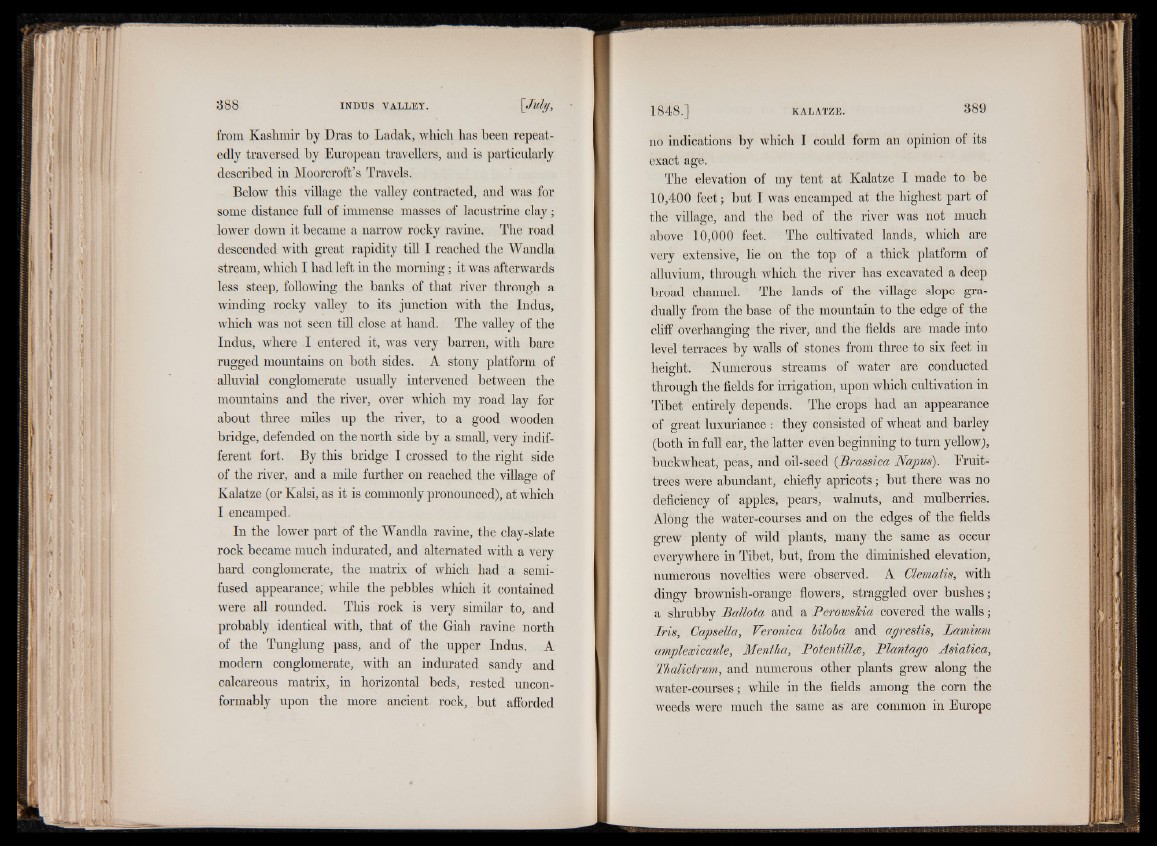
from Kashmir by Dras to Ladak, which has been repeatedly
traversed by European travellers, and is particularly
described in Moorcroft’s Travels.
Below this village the valley contracted, and was for
some distance full of immense masses of lacustrine clay;
lower down it became a narrow rocky ravine, The road
descended with great rapidity till I reached the Wandla
stream, which I had left in the morning; it was afterwards
less steep, following the banks of that river through a
winding rocky valley to its junction with the Indus,
which was not seen till close at hand. The valley of the
Indus, where I entered it, was very barren, with bare
rugged mountains on both sides. A stony platform of
alluvial conglomerate usually intervened between the
mountains and the river, over which my road lay for
about three miles up the river, to a good wooden
bridge, defended on the north side by a small, very indifferent
fort. By this bridge I crossed to the right side
of the river, and a mile further on reached the village of
Kaiatze (or Kalsi, as it is commonly pronounced), at which
I encamped.
In the lower part of the Wandla ravine, the clay-slate
rock became much indurated, and alternated with a very
hard conglomerate, the matrix of which had a semi-
fused appearance; while the pebbles which it contained
were all rounded. This rock is very similar to, and
probably identical with, that of the Giah ravine north
of the Tunglung pass, and of the upper Indus. A
modem conglomerate, with an indurated sandy and
calcareous matrix, in horizontal beds, rested uncon-
formably upon the more ancient rock, but afforded
no indications by which I could form an opinion of its
exact age.
The elevation of my tent at Kaiatze I made to be
10,400 feet; but I was encamped at the highest part of
the village, and the bed of the river was not much
above 10,000 feet. The cultivated lands, which are
very extensive, lie on the top of a thick platform of
alluvium, through which the river has excavated a deep
broad channel. The lands of the village slope gradually
from the base of the mountain to the edge of the
cliff overhanging the river, and the fields are made into
level terraces by walls of stones from three to six feet in
height. Numerous streams of water are conducted
through the fields for irrigation, upon which cultivation in
Tibet entirely depends. The crops had an appearance
of great luxuriance : they consisted of wheat and barley
(both in full ear, the latter even beginning to turn yellow),
buckwheat, peas, and oil-seed (Brassica Najms). Eruit-
trees were abundant, chiefly apricots ; but there was no
deficiency of apples, pears, walnuts, and mulberries.
Along the water-courses and on the edges of the fields
grew plenty of wild plants, many the same as occur
everywhere in Tibet, but, from the diminished elevation,
numerous novelties were observed. A Clematis, with
dingy brownish-orange flowers, straggled over bushes;
a shrubby Ballota and a Perowskia covered the walls1
Iris, Capsella, Veronica biloba and agrestis, Lamium
amplexicaule, Mentha, Potentillce, Plantago Asiatica,
Thalictrum, and numerous other plants grew along the
water-courses while in the fields among the corn the
weeds were much the same as are common in Europe